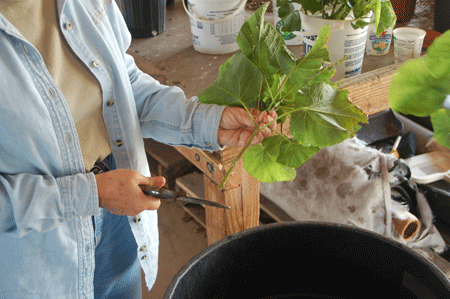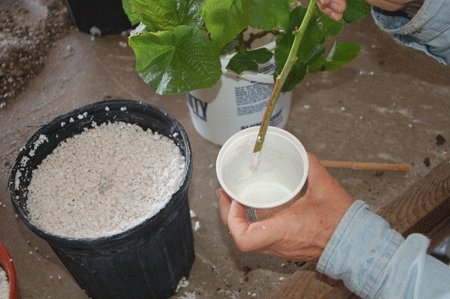Growing Plants from Cuttings

As published in the Miami Herald
Growing plants from cuttings is a method of plant propagation that produces new plants that are genetically identical to the parent plant. This is desirable trait if you are trying to maintain a characteristic such as superior fruiting or flowering. Cuttings do not typically work with monocots such as grasses and palms, but will work with most dicots. Making cuttings involves removing a small portion of a mature plant to get it to root. May through September is the best time to make cuttings.
 |
| Always make a fresh cut when preparing cuttings. |
When taking cuttings, look for plant material about the width of a pencil and about 10 to 12 inches long. Cuttings are usually taken from the tips of plants but may also be taken from the woody portion of the plant further down the stem. If you are unsure which portion of the plant will make the best cutting, take cuttings from multiple areas. Cuttings should be made from only healthy plants, moistened and then placed in a plastic bag immediately after being cut to avoid water loss which will be great if the cutting is left in open air. After the cuttings are collected, they should be potted immediately. Cuttings should be potted in one-gallon containers in pure perlite that has been rinsed with fresh water. Perlite is a type of media mix that does not hold water and allows air movement around the cuttings. Some cuttings may be placed in a well-draining soil mix.
 |
| Dip the cuttings into rootone before potting. |
Before the cuttings are potted, the lower leaves should be removed along with any flowers or fruits. The lower leaves are removed so the plant can be placed easily into the media-mix and the flowers and fruits are removed so they do not sap energy from the process of root generation. If the cutting has a large mass of leaf area, about 1/3 of the leaves may be removed. This is done so the plant does not lose an excess of water due to transpiration. A fresh cut should then be made at the base of cutting just below a node and the cutting may be dipped in rootone. Rootone is a man-made product that mimics natural hormones in the plant which signal that it is time to produce roots. After the cutting is dipped in rootone, it is a good idea to place a pencil in the perlite in order to make a hole in which to place the cutting. If the pencil does not clear the way for the cutting, the rootone will be scraped off when the cutting is placed in the perlite. Once the one-gallon container is filled with cuttings (usually 3-5) the container should be kept moist. Cuttings in perlite should be placed on a mist bench. A mist bench employs an irrigation system and a mist head to lightly spray the cuttings keeping them moist and humid during the day. This is necessary because a cutting does not have roots to collect water. Cuttings in perlite may also be placed in a plastic bag to create a humid environment using the greenhouse effect, but this technique is far less desirable than the mist bench. If placed in a plastic bag, make sure the leaves do not touch any portion of the bag and that the container is placed in shade and not full sun as full sun will damage the plant. Once the cuttings have produced roots (after about three to five weeks), they should be removed from the mist bench and potted individually into one-gallon containers. When repotting, be careful of the tender new roots and make sure they are placed below the soil line and the stem above the soil line. These new plants can be grown in a protected area with dappled sunlight until the roots fill the containers. At this point, the plants should be repotted into larger pots or placed in the ground.
 |
| Several cuttings can fit in one container. |
For more information about plant propagation, including air-layers, grafting and growing plants from seed, visit www.fairchildgarden.org/gardening.
